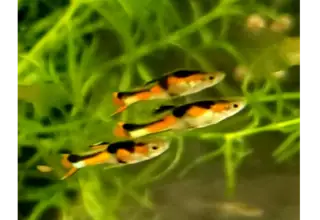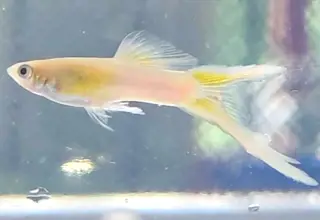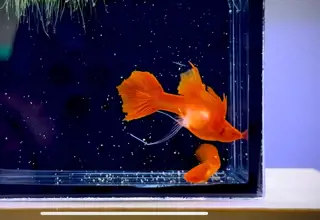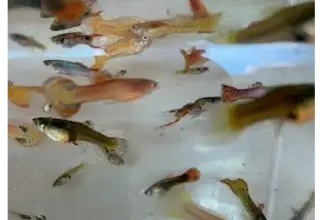Queen Arabesque Pleco: The Complete Care Guide
Posted by Miles Harrison on 11/03/2022
We use affiliate links and may receive a small commission on purchases.
If you’ve never seen a queen arabesque pleco before, you might be wondering why this fish is so popular. Hypostomus plecostomus, also known as the suckermouth catfish, are tropical freshwater fish that have been making their way around the aquarium community for decades. With over 150 different types of species in the genus, the queen arabesque stands out amongst the rest.
Aquarists prize this species for its manageable size, and striking color patterns. Highly sought after, this rare fish comes with a premium price tag. If you’re deciding whether or not a queen arabesque pleco could be the right fish for you, you’re in luck, because we’re going to discuss all of the topics about this amazing species.
January's Giveaways on Light Fish
Species Summary
If you’re new to pleco keeping, you might notice that they have an L classification system in addition to their common names. This system, developed by German aquarist Rainer Stawikowski, was created as a potential naming solution for fish that were not formally scientifically classified.
The Queen Arabesque Pleco (Smalstribet Sugemalle) also known as L260, is without a doubt one of the most attractive plecos. These fish, similar to other Plecostomus fish, are easy to care for and fun to observe.
Known to be quite hardy, their care requirements make them excellent fish for beginners new to the hobby. Experienced hobbyists will be stunned by their zebra-like appearance and peaceful temperament.
Native to the Tapajos river, a 500+ mile waterway that cuts straight through the amazon rainforest, the queen arabesque pleco lives a nocturnal lifestyle. During the day, these fish can be found resting in caves, or small crevices along the banks of the river. At night, these fish will search for high-protein food sources, often consuming small crustaceans and algae.
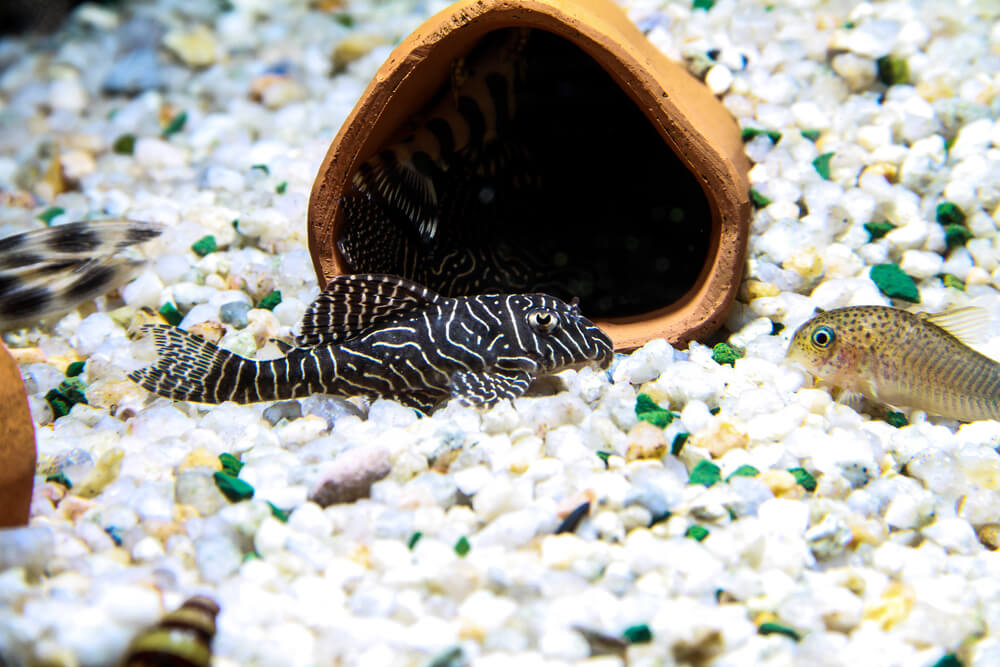
Appearance
Queen Arabesque Plecos are visually very striking. The body of this fish is black wrapped with a curvy, zebra-like pattern. Their suckermouth faces are quite comical, and they make frequent use of their downward-facing mouths.
Similar to other plecos, the queen arabesque pleco has a large dorsal fin and massive, webbed pectoral fins. Combined, the fish's dorsal and tail fins make up half the length of the fish's body.
The dark coloration and unique patterns of this fetch help it blend into its natural environment, where camouflage is needed against potential predators. In the wild, these fish do their best to stay clear of pelicans, herons, and even alligators.
🛒 Shop Freshwater Fish on Light Fish
Size
Males will be slightly larger than females, but you can expect adult Queen Arabesque Plecos to grow to be 3.5 inches in length.
This is typically the same size you’ll see for this species in the wild. Feeding this fish a diet that’s full of high-quality nutrients will improve the chances that your fish will successfully reach their full adult length.
You’ll also want to make sure that you’re providing an aquarium that’s large enough for this fish. Having a smaller tank often results in territory disputes. These disputes will stress your fish and can affect their growth and quality of life.
Queen Arabesque Pleco Care
One of the best parts about owning a Queen Arabesque Pleco, is that they’re not very fussy when it comes to care requirements. These bottom-feeding fish can live successfully in most freshwater conditions, but there are still some rules you’ll need to follow if you plan on caring for this fish.
You’ll want to recreate the Queen Arabesque’s native environment as closely as possible. While it may seem daunting to try and re-create the water conditions of the Amazon in a home aquarium, fear not, because it can be done!
Let’s start by discussing the appropriate-sized aquarium for this wonderful species.
Tank Size
You’ll want to have an aquarium that’s at least 20 gallons if you plan on keeping a Queen Arabesque Pleco.
Unfortunately, you’re out of luck if you were planning on keeping multiple Queen Arabesque Plecos in one aquarium. While these fish do well with most peaceful schooling fish they won’t do well with other plecos, as they are quite territorial.
Lifespan
The queen arabesque pleco can live for quite a while, and aquarists have reported these fish living for up to 10 years in captivity.
Providing these fish with a nutrient-rich diet, proper water conditions, and a stress-free living situation will give you the best chance of keeping these fish for the longest time possible.
Water Conditions
Luckily for new aquarists, the Queen Arabesque Pleco can adapt to an aquarium environment quite easily.
In Brazil, these fish live in oxygenated, fast moving rivers, where water is pH neutral, and temperatures tend to be quite warm.
You’ll want to recreate these conditions by aiming for the following water conditions if you plan on keeping a Queen Arabesque Pleco.
Temperature Range: 73°F-82°F
pH Range: 6.0–7.6
KH: 3-10 DKH
You’re going to want to maintain these conditions for the duration of your plecos life. One of the best investments you can make as an aquarium hobbyist is a reliable water testing kit . You should regularly test your water to make sure ammonia and nitrite levels are consistently at 0 ppm.
Tank Setup
Queen Arabesque Plecos are messy fish. They produce a lot of waste, so you’ll need to stay on top of water changes to maintain optimal water conditions. Having plenty of aquarium plants can reduce the effect of fish waste, as they can utilize fish waste to produce new leaves. Queen Arabesque Plecos are not known to pick at plants, so you should have no problems growing aquatic plants such as Hygro and Taiwan Lilies
Slow-growing plants, such as Anubias Frazeri and Anubias Barteri are also great options to give your aquarium a more natural feel.
Plecos are bottom-dwelling fish, so you’ll want to decide on a good substrate. Substrates such as CaribSea’s eco-complete provide plenty of nutrients for aquatic plants to consume. If you decide not to add aquatic plants, any gravel based substrate will be suitable for a Queen Arabesque.
You can give your aquarium a much more natural look by adding driftwood or aquarium-friendly stones. You can position these to form natural caves and small caverns, queen arabesque plecos love to rest in these environments, witnessing a pleco lounging in a cave you’ve created is fun to witness!
These fish live in fast-moving streams, so you’ll want to make sure that you have an appropriate filter rated for your aquarium size. You can create additional movement throughout the tank by adding an aquarium powerhead .
Having an aquarium heater is a must when keeping these fish, as they come from warm-water tropical environments. Make sure that you have a heater that can maintain a warm temperature in your aquarium. You can monitor water temperatures by purchasing a reliable aquarium thermometer .
One of the best parts about owning a pleco, is that they’re not known jumpers, so you won’t need to purchase a lid unless you plan on keeping these fish with other species known to jump.
Common Diseases
Queen Arabesque Plecos are susceptible to all of the common diseases that affect freshwater fish. One of these most common diseases is known as Ich, or White Spot Disease. You’ll know if your pleco is suffering from this disease, if you notice a collection of small white dots on the body of the fish. Fish that experience this disease may be slightly more lethargic than usual. Treatment typically involves moving your fish to a quarantine tank for a few weeks, where you can monitor your fishes health and treat them with remedies such as API Super Ick Cure.
Another issue Queen Arabesque Pleco owners occasionally face is called fin rot. As you may have guessed, this bacterial infection directly impacts a Pleco’s fins, and they will appear tattered and torn. In severe cases, a large portion of the fin may appear that it’s melting away.
Water Conditions are usually the number culprit for the onset of this infection. Luckily, treatment is straightforward. Perform gradual water changes every day until ammonia and nitrite levels are in check. If your tank is fully cycled, you’ll want to use a water test kit to make sure that both levels are at 0ppm. Continue providing your Queen Arabesque Pleco a high-quality diet of nutrient rich food, and ensure they aren't suffering from stress due to tank mates or an aquarium that’s too small for their liking. Over time, the fins should regrow.
It’s always best to prevent these issues from occurring, and ensuring that your fish aren’t under stress from aggressive tank mates, such as an electric blue jack dempsey will give your fish the best chance to fend off this diseases and parasites. Performing weekly 50% water changes will guarantee your water chemistry doesn’t become unmanageable.
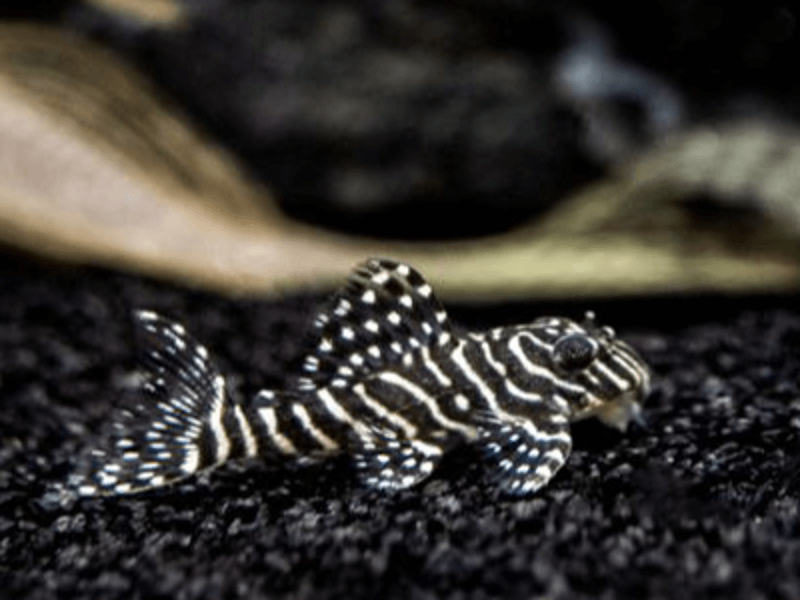
Food & Diet
One of the biggest misconceptions with plecos is that they are huge algae eaters. While they are in fact bottom feeders, and do occasionally eat algae, they are omnivorous fish, and should be fed a protein-rich diet.
We recommend feeding these fish a mix of bloodworms, sinking pellets, algae wafers and daphnia. Vegetables such as peas, lettuce, and zucchini will also be enjoyed by the Queen Arabesque Pleco. Feed these fish at least once a day, and feed them no more than what they can consume in a 2 minute period. Extra food will turn to waste, creating an unstable environment for your aquarium inhabitants.
Behavior and Temperament
Overall, these fish are quite peaceful. You’ll often finding them buried in the substrate, or hiding in caverns and small caves throughout the aquarium. You’ll typically find these fish along the bottom of the aquarium, it’s where they prefer to be! If you haven’t kept a pleco before, you might think there is something wrong with your fish since they’re always at the bottom of the tank. But fear not, as this is the same behavior they exhibit in their natural environment.
The one thing that you’ll need to watch out for, is keeping a Queen Arabesque Pleco with another pleco. These fish are territorial within their own species, and keeping more than one in the same aquarium is a recipe for disaster. Having a large aquarium can reduce the chances that these fish will show signs of aggression, but we still recommend avoiding this situation altogether.
Tank Mates
The Queen Arabesque Pleco will do great with most peaceful community fish, and can even co-exist comfortable with invertebrates such as orange pumpkin shrimp and black mystery snails.
The following fish are some of our favorites, and will do well with a Queen Arabesque Pleco.
- Cardinal Tetras
- Purple Moscow Guppies
- Blue Diamond Discus
- White Cloud Mountain Minnows
- Koi Angelfish
- Bluefin Nothos
Avoiding pairing the queen arabesque pleco with aggressive fish species. Aggressive fish will bully a peaceful Queen Arabesque, this bullying will stress the fish and weaken it’s immune system.
Stay clear of the following tank mates if you plan on keeping a Queen Arabesque Pleco:
- Platinum Parrot Fish
- Red Dragon Flowerhorn Cichlids
- Electric Blue Jack Dempsey
- Galaxy Koi Betta
- Tiger Barbs
You’ll also want to avoid adding any additional plecos, as these fish prefer to be the only plecostomus species in an aquarium environment.
Breeding
Breeding an L260 Queen Arabesque Pleco in captivity is possible, but it’s definitely not something a casual aquarist will be able to pull off without doing proper research. If you’re interested in breeding this species, we recommend having two available females for your breeding male. This will increase the chances that these fish will pair up. Queen Arabesque Plecos should be at least 1-1.5 years old to breed.
You’ll want to establish a breeding tank that matches the water conditions of your main aquarium. It should be set up in a similar fashion, and you should have plenty of driftwood or small caves for your fish to hide in. You can add a breeding cone which can serve as a surface for your female to lay her eggs. Female Queen Arabesque Plecos can lay over 20 eggs at once, and typically hatch after one week. These eggs will be heavily guarded, and once hatched, you’ll have the difficult task of raising the fry.
Fry are extremely sensitive to poor water quality, and you’ll want to perform daily 10% water changes to ensure your breeding tank water is in tip-top shape. You’ll need to feed the fry multiple times a day, with a nutrient-rich diet consisting of broken up shrimp and chopped up flake food. Fry can also be fed powdered spirulina and infusoria, as well as baby brine shrimp.
Pleco fry will start to look more like adult plecos after about 4 weeks. It’s very difficult to successfully raise all of the fry, but if some have lasted, you’ve successfully bred the Queen Arabesque Pleco!
Conclusion
As you can see, plecostomus fish truly stand out amongst the rest of aquarium freshwater fish. Their distinct appearance and curious personalities make these fish very popular in the hobby. Some aquarists prize these fish so much that they specialize exclusively in caring for plecos.
While some pleco species are more popular than others, the Queen Arabesque is at the top of our list for best looking. Their wild patterns, peaceful temperament, and small size makes this fish one of our absolute favorites, and we’re sure you’ll enjoy this fish as much as we do.
So what will it be, do you think the Queen Arabesque Pleco will be the next fish you add to your aquarium? We’d love to hear from you! If you enjoyed reading this post, we discuss plecos in more detail on our community forum, where we share aquarium related content and discuss everything there is to know about fishkeeping. Thanks for reading!
January's Giveaways on Light Fish


